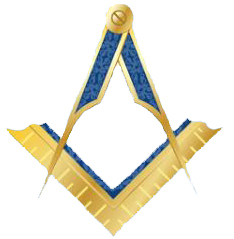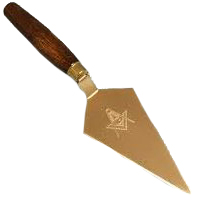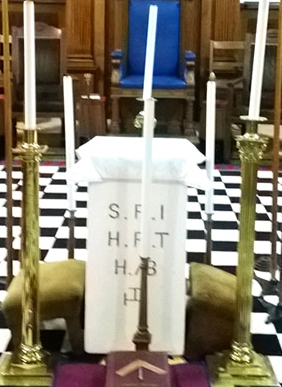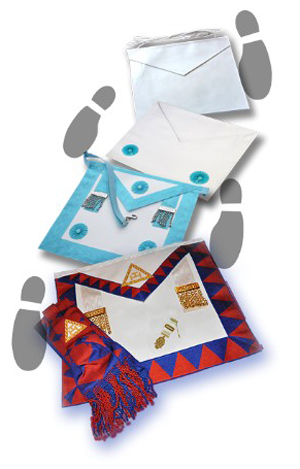
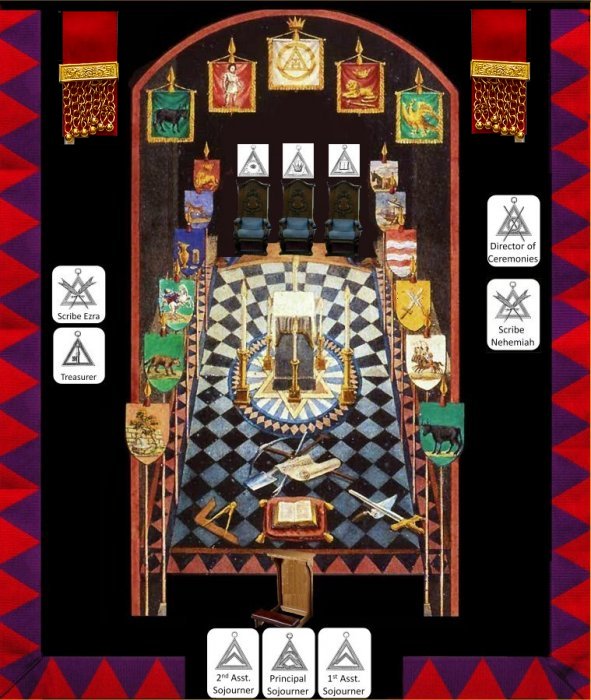
Banner – Ox
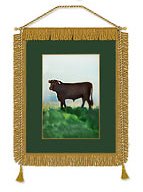 The Ox banner is the third principal banner and relates to the Tribe of Ephraim, that camped in the west, and therefore, like the ensign of this same tribe it bears the figure of an ox. The words of Moses in Deuteronomy chapter 33 point out that the creature that was their symbol was sometimes a bull, a bullock or even a calf.
The Ox banner is the third principal banner and relates to the Tribe of Ephraim, that camped in the west, and therefore, like the ensign of this same tribe it bears the figure of an ox. The words of Moses in Deuteronomy chapter 33 point out that the creature that was their symbol was sometimes a bull, a bullock or even a calf.
These animals, just because they represented creatures of great strength, were those that were frequently chosen for sacrifice on the great altar of the Temple at Jerusalem. It was this fact that linked the ox with the Gospel writer, St Luke, since he was the one who specially told the story of the sacrifice of Christ.
The colour associated with Ephraim was dark or bluey green and this linked up, as we learnt earlier, with a jasper. The green colour also relates to the further blessing that was associated with the sons of Joseph: ‘the choicest fruits of the sun and the finest produce of the ancient mountains’.
Banner – Man
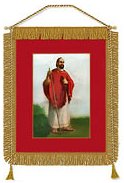 The man banner is the second principal banner. It bears another representative emblem of the tribe of Reuben. In this case the symbol used is totally different to that of the ‘waves’, that is shown on the ensign of Reuben. This, however, is just as appropriate because it was then noted that the name Reuben meant ‘Behold a son’ and Jacob’s words in Genesis chapter 49 are similar: ‘This is my first born, my might, the first sign of my strength’. It is therefore hardly surprising that such words might suggest the figure of a man.
The man banner is the second principal banner. It bears another representative emblem of the tribe of Reuben. In this case the symbol used is totally different to that of the ‘waves’, that is shown on the ensign of Reuben. This, however, is just as appropriate because it was then noted that the name Reuben meant ‘Behold a son’ and Jacob’s words in Genesis chapter 49 are similar: ‘This is my first born, my might, the first sign of my strength’. It is therefore hardly surprising that such words might suggest the figure of a man.
What can be a matter of great interest when visiting another chapter is discovering the type of man that is shown in each case. Since the words of Jacob include the following: ‘You shall not excel because you went up to my couch and defiled it’ the man on this banner is sometimes shown partially naked with but a scanty cloak, and hence sometimes it looks like John the Baptist. Other figures look like a king or prophet and this is also appropriate because, as this symbol was later used to represent St Matthew, who told the story of God becoming man amongst the Jews, it is right to see this figure as a teacher or leader.
The colour connected with this banner was flesh-coloured or pink-red and this linked up with the cornelian stone in the High Priest’s breastplate.
Banner – Tau
 The triple tau which may be described as the true distinguishing mark of the Royal Arch.
The triple tau which may be described as the true distinguishing mark of the Royal Arch.
The requirement of a ‘mark’ is not accidental because all those who were true Master Masons in earlier days had already passed through what we now call the Mark degrees and had been provided with their special and personal Mark. The Tau is certainly a mark of ‘perfect life’, as we are taught in this Order from the Book of Ezekiel.
Bearing in mind, however, the original association of this Order with Moses, a possible Egyptian reference is not out of place. The ‘T’ form of this Mark was exactly the same as that of the instrument known as a Nilometer, which was placed beside that great river at the time of its annual flooding. If the water reached the crossbar then irrigation was assured and the crops providing food for the whole population was again assured. The Tau has also a reference to the Cross.
The Romans made a convicted criminal carry the cross beam to the place of execution and then that beam was laid on top of the upright stake that was already fixed in the ground. The notice of the prisoner’s crime was then sometimes nailed to the back of the cross beam, thus giving the outline with which most of us are familiar.
The Tau has the true shape of the cross itself. The union of the three taus corresponds at least to the idea of the three principal’s uniting for their proper communication of the Royal Arch secrets.
Banner – Lion
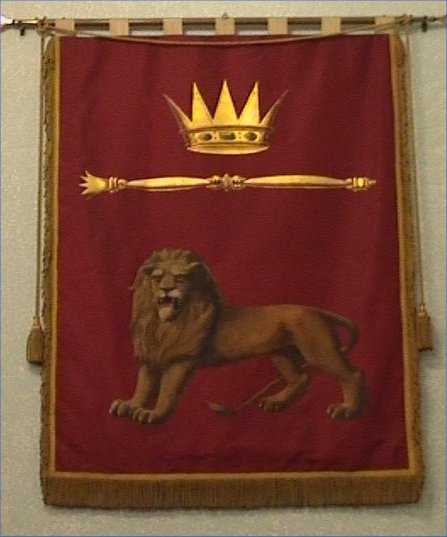 The lion banner is the first of the principal banners, it displays a lion and is so placed in the Book of Numbers, chapter 2 verse 3 – 9.
The lion banner is the first of the principal banners, it displays a lion and is so placed in the Book of Numbers, chapter 2 verse 3 – 9.
The lion was the emblem of Judah, the tribe which was to produce the royal line of David and Solomon. In the Book of Numbers we also read that Judah’s companies were to be placed in the East, towards the point of the sunrise, when the Israelites made camp in the wilderness of Sinai. That, in current Masonic terms, certainly indicates a position of rule and majesty.
The colour portrayed on this first banner is crimson or blood red and this agrees with more of the words used by Jacob in Genesis chapter 49: ‘Judah will tether his donkey to a vine, washing his garments in wine and his robes in the blood of grapes’. This also fits in with the colour of the carbuncle jewel which represented Judah in the High Priest’s breast-plate. The later connection of the lion with St Mark was because the gospel bearing his name begins with the words, ‘The voice of one roaring in the wilderness’.
Banner – Eagle
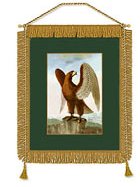 The eagle banner is the fourth and last of the principal banners and as the name suggests it displays an eagle. Since this banner is representative of the tribe of Dan it may at first seem strange that this symbol is so different from that on the ensign, a horseman whose steed is attacked by a serpent. Yet there is a connection with the zodiac sign of Capricorn, an eagle with a serpent in its grasp. There is another passage in Genesis chapter 48 verse 18 where we read: ‘I look for your deliverance, 0 Lord’, and this comes at the end of the section relating to Dan.
The eagle banner is the fourth and last of the principal banners and as the name suggests it displays an eagle. Since this banner is representative of the tribe of Dan it may at first seem strange that this symbol is so different from that on the ensign, a horseman whose steed is attacked by a serpent. Yet there is a connection with the zodiac sign of Capricorn, an eagle with a serpent in its grasp. There is another passage in Genesis chapter 48 verse 18 where we read: ‘I look for your deliverance, 0 Lord’, and this comes at the end of the section relating to Dan.
This has been linked in the past with Moses’s words in Deuteronomy where he says: ‘The Most High shielded him and cared for him, like an eagle that alerts its nest and hovers over its young, spreading its wings to catch them and carry them on its pinions’. The link of the eagle with St John the Evangelist may relate to several themes: the good news brought to God’s brood as if by a flying angel, or to the heavenward ascension of Christ; or even, as has been said, when the eagle holds a serpent in its claws, thus signifying the conquest of good over evil.
The colour of this banner is light green, for the tribal stone as worn by the High Priest was a sapphire.
Scribe Ezra
 Scribe Ezra, in the Scriptural account was the leader of the second group of Israelites who returned to Jerusalem. Much of the building of the next Temple had been completed by the time he arrived so that his task was to ensure the restoration of the Law of Moses as that which was taught and followed by those attached to the Temple, whether as its servants or its attendants. That is why in our chapter lectures scribe Ezra is described as an ‘expounder of the Sacred Law’. The name means ‘help’.
Scribe Ezra, in the Scriptural account was the leader of the second group of Israelites who returned to Jerusalem. Much of the building of the next Temple had been completed by the time he arrived so that his task was to ensure the restoration of the Law of Moses as that which was taught and followed by those attached to the Temple, whether as its servants or its attendants. That is why in our chapter lectures scribe Ezra is described as an ‘expounder of the Sacred Law’. The name means ‘help’.
Ezra was both a priest and scribe and was a leading figure in the revival of Judaism in the land of Israel after the Babylonian captivity. Ezra, a scholar and teacher, was given official sanction to teach the law, appoint magistrates, offer sacrifices, and beautify the Temple. He was the person responsible for defining both Temple worship and the canon of scripture for his time. Ezra certainly had a part in making the ‘People of the Book’. The book of Ezra describes the rebuilding of the Temple, which is reported in detail elsewhere only in the books of Haggai and Zachariah. This story is central to the Royal Arch, you may wish to consult it.There is no reliable record to be found concerning Ezra’s death, but it is assumed that he returned to Babylon where he died.
His work was especially necessary because the returned exiles had become used to speaking and writing in the Chaldee tongue and they now had to become familiar once more with the original Hebrew text of the Scriptures. It is interesting to learn that though Ezra taught the people Hebrew he wrote what was to be taught in the Chaldean alphabet.
Ezra collected the ancient Sacred Books of his people and circulated copies of the Holy Scriptures. It is tradition among the Jews that, by Ezra’s legendary achievements, the services of the Synagogues were established.
Because Ezra was a learned person who sought to instruct the people in the Holy Scriptures it is not surprising that in English chapters he still wears a surplice, the dress of a speaker or teacher in the established church of this land. The white of his clothing also relates to what was once the white veil that was reached when the three other veils ceremony ended and that divided the candidate from the Holy of Holies where the three principal’s were meant to be seated. To further represent this veil many chapters require the scribes to stand by the easternmost staves when the candidate is being obligated.
The Treasurer
 The treasurer is responsible for the finances of the chapter. Annually he produces a financial summary report, which is submitted to the auditors, who are elected from within the chapter membership.
The treasurer is responsible for the finances of the chapter. Annually he produces a financial summary report, which is submitted to the auditors, who are elected from within the chapter membership.
It is the responsibility of each companion to pay his subscriptions, together with any dining charges to the treasurer promptly.
The treasurer settles any debts incurred by the chapter, such as the rent for the building where meetings are held, the various levies imposed by Supreme Grand Chapter and Provincial Grand Chapter, and dining expenditure.
A treasurer requires sound judgment, for ultimately, it is on his recommendation that the level of subscriptions for members is set.
Principal Sojourner
 A sojourner (Journeyman Mason) is one who arrives as a stranger with every intention of moving on in due course. The ritual relates how the three sojourners who arrived to offer their assistance with the rebuilding work proved pivotal in rediscovering the lost secrets, offering the message that those employed on the lowly tasks may attain the highest honours through zeal and industry.
A sojourner (Journeyman Mason) is one who arrives as a stranger with every intention of moving on in due course. The ritual relates how the three sojourners who arrived to offer their assistance with the rebuilding work proved pivotal in rediscovering the lost secrets, offering the message that those employed on the lowly tasks may attain the highest honours through zeal and industry.
Principal sojourner is an officer of the chapter but as the name suggests it originally represented someone who came from outside and requested the opportunity to ‘sojourn’, or spend days, in the company of the companions and assist them in their labours.
At one stage in the 18th century the candidates were called ‘the sojourners’ and as three candidates were required for the ceremony, as is still the case in some parts of the United States of America, the idea of three sojourners began.
At this point the obligated candidates once simply listened to a lecture but as the ceremony developed the need for three more officers became evident. In the chapters held in the Antients’ lodges there was the Excellent (or Super Excellent) Master degree that is more popularly known as the ‘Ceremony of the Veils’. In that ceremony the principal sojourner (PS) was known as the captain of the third veil. It was as one passed through that veil that the first mention of God’s true name was given. After 1834 this ceremony was discontinued in England and the form that is presently practised was established.
The role of PS is basically that of the discoverer of the secrets in the vault but it has always to be remembered that this is on done on behalf of the candidate so the old role in that position is in part restored. What might seem strange is that, as in the west of a lodge, it is the principal sojourner’s privilege to close the chapter.
An ancient link with Craft working is thus retained.
First Assistant Sojourner

The first assistant sojourners traditional task, as hinted by the principal sojourner, was to offer services as one of the Israelites returning from Babylon, to help reconstruct the Temple in Jerusalem that was destroyed by the Assyrians. There was a time before 1834 when another degree was practised before the actual exaltation. The degree was conducted in three parts, each of which were separated by one of three curtains coloured blue, purple and crimson. These colours are still recalled by the colours of the robes of the three principal’s and also the colours of the Royal Arch jewel worn by those promoted to Provincial grand rank.
The first assistant sojourner was appointed to be in charge of the second or purple curtain and was known as the captain of the second veil. Within the area behind that veil candidates were reminded of the encounter between Moses and the Pharaoh who ruled Egypt, prior to the release of the Hebrews from that land. It may be noted that this Veils ceremony emphasises the idea of release from exile that is still a theme retained in our current practice.
In Scotland it is the custom for the office of first assistant sojourner to be the one who is lowered into the vault rather than the principal sojourner.
Second Assistant Sojourner
 The second assistant sojourner is sometimes called the junior assistant sojourner. Mention has already been made of why there are three sojourners and of other duties which they performed in the late 18th and early 19th centuries Those tasks are still performed in Bristol where a ceremony of the veils was allowed to be reintroduced almost a century ago.
The second assistant sojourner is sometimes called the junior assistant sojourner. Mention has already been made of why there are three sojourners and of other duties which they performed in the late 18th and early 19th centuries Those tasks are still performed in Bristol where a ceremony of the veils was allowed to be reintroduced almost a century ago.
It may be of interest to learn that in West Yorkshire today there is a chapter that uses the older and much longer opening ritual that involves the questioning by the MEZ of each of the officers as to what are their several duties. The second assistant sojourner gives the answer ‘The captain of the first veil’ and the duty of that office is ‘To guard that veil and allow none to pass without giving the word and grip of that veil and to report the same to the captain of the third veil’. Thus is retained the memory of the older form of part of Royal Arch Masonry.
Such practice reminds us of the antiquity of our ceremonies and the fact that the second assistant sojourner office, like others, is not there by chance. Even the name of sojourner emphasises that whilst sojourners may first have been temporary visitors they are now necessary parts of the whole exaltation process.
Director of Ceremonies
 The DC, as his title implies, has the job to direct the ceremonial aspects of our meetings. The DC’s role is to make certain that ceremonies are efficiently conducted with dignity and decorum and that all concerned are aware in advance of what they have to do.
The DC, as his title implies, has the job to direct the ceremonial aspects of our meetings. The DC’s role is to make certain that ceremonies are efficiently conducted with dignity and decorum and that all concerned are aware in advance of what they have to do.
The DC will ensure that all equipment is correctly laid out and that a suitable apron, sash and jewel are available for a candidate during an exaltation ceremony. The DC will also ensure that the correct passages of scripture readings are available for the principal’s to recite from.
The DC’s role is a vital one in any lodge. Ideally he will liaise with the principal’s and scribe Ezra to plan the calendar for the year. He will ensure in good time that all officers are able to make the meeting and arrange substitutes for those who can’t as far ahead as possible. He will oversee the janitor’s preparation of the chapter room and make sure that all items needed for the meeting are in place. For all meetings, but particularly for the installation, he will plan any necessary processions and salutations.
During the meeting he will ensure that proceedings flow and that movement round the chapter room is ‘smooth and polished’.
He will have overall responsibility for the festive board and ensure that companions know if they are proposing or responding to a toast. He will oversee training of officers at chapters of instruction even if he delegates some of the running of them to the ADC. He will involve the ADC in as much work as possible to prepare him for any occasion when he needs to deputise for him and possibly in time, to succeed him.
The Janitor
 The principle of having someone to keep the meeting places of Freemasons private and safe meant that every part of the fraternity had its own officers to discharge this task. In the 18th century, whether the Royal Arch was conducted as part of the Craft practice, as with the Antients, or as a separate but attached practice of some lodge members, the person who kept the outer door was the same tyler for both. When the Royal Arch was organised separately from the Craft, and especially after 1834, a new title was given to the keeper of the outer door. He was now called the janitor.
The principle of having someone to keep the meeting places of Freemasons private and safe meant that every part of the fraternity had its own officers to discharge this task. In the 18th century, whether the Royal Arch was conducted as part of the Craft practice, as with the Antients, or as a separate but attached practice of some lodge members, the person who kept the outer door was the same tyler for both. When the Royal Arch was organised separately from the Craft, and especially after 1834, a new title was given to the keeper of the outer door. He was now called the janitor.
The term was an appropriate one in Freemasonry for it derives from the same Roman God, Janus, with two faces, who gave his name to January, the month that looks back on the past year and looks forward to the new.
The Janitor guards the outside of the door to the chapter. This is an elected office, it is often carried out by a senior and experienced companion, as he is the officer who prepares the candidate for exaltation. The janitor is not necessarily a member of the chapter.
The janitor is the one who, while keeping a wary eye out for strangers and intruders is also expected to care for the new candidate as he prepares for his fresh experiences in the chapter. Having their old Craft lodge connection firmly in mind some old chapters today still have an outer janitor and an Inner one. This is not a tradition that ought to be maintained for it is hoped that the status of the scribe Nehemiah needs to be recognised as being of more significance than that of a mere doorkeeper.
Scribe Nehemiah
 Nehemiah was a 5th century BC Jewish leader. Nehemiah was the leader of the third group of Jews returning to Jerusalem. In exile he had been the king’s cup-bearer, or the one who tested what he might drink before he did so. He held a position of honour in the court of the Persian King Artaxerxes and in 444 BC was appointed by the king to the governorship of Judea, with authorisation to rebuild Jerusalem.
Nehemiah was a 5th century BC Jewish leader. Nehemiah was the leader of the third group of Jews returning to Jerusalem. In exile he had been the king’s cup-bearer, or the one who tested what he might drink before he did so. He held a position of honour in the court of the Persian King Artaxerxes and in 444 BC was appointed by the king to the governorship of Judea, with authorisation to rebuild Jerusalem.
The rebuilding of Jerusalem and the reforms made during his administration are recounted in the book that bears his name. On his return he was also, like scribe Ezra, appointed an officer of the Sanhedrin and given the role of a scribe.
The name means ‘God’s consolation’ and his task was to superintend the rebuilding of the walls of Jerusalem so that the Temple and people might be safe from the attacks of those who resented the attitude of the exiles’ descendants. Some of these opponents were the Samaritans and that is why there was conflict between them and the Jews for centuries afterwards.
Scribe Nehemiah was a cupbearer at the Royal palace to the Persian King, Artaxerxes. He had heard that after the building of the Temple by Zerubbabel, the people were still persecuted by their enemies and they were unable to rebuild the city walls.
Nehemiah’s first impulse always was to pray and he spent four months in prayer before making his request to the King. The King hearing of his concerns, immediately sent Nehemiah with a suitable guard and a Royal letter giving him assistance and full powers as Governor to rebuild the city walls.
Nehemiah suffered accusations of treasonous intentions against the King, who instructed the rebuilding to be stopped, but the builders, with trowel in hand and sword at their side, finished the city walls in 52 days, before the King’s command arrived.
Nehemiah, having returned to Persia to defend his good name, travelled back to Jerusalem with increased powers from the King. He erected the city gates, repaired the houses of the city and took measures to increase the number of inhabitants within the city walls, so that they could adequately defend themselves. He then completed the repairs of the Temple and devoted himself to rectifying many grave evils.
The distinction of his office is marked by the wearing of a surplice and this garb of a teacher should remove any notion of his office being the chapter equivalent of an inner guard, wherever he may be placed.
His duty is to assist the scribe Ezra and in some chapters it is further marked by our doing the veiling and unveiling of the pedestal rather than by the principal’s. In any case it is the scribe’s privilege to equip the men who are engaged for the work of clearing the new Temple’s ground and then further preparing them for their investiture. It is not a menial task but a respected office and scribe Nehemiah is the first officer of the chapter seen by any candidate as he is admitted.
First Principal
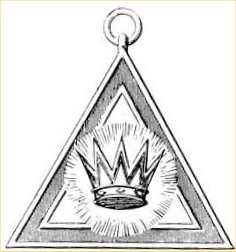 Zerubbabel is the first principal of the chapter and is in charge of the convocation, the name that we give to a meeting of a Royal Arch chapter.
Zerubbabel is the first principal of the chapter and is in charge of the convocation, the name that we give to a meeting of a Royal Arch chapter.
The chapter is the place where those who are fully qualified Master Masons meet to learn about and share the complete or supreme knowledge of ‘The Mason’s Craft’. Three are needed to rule a chapter because originally the revelation of the great secret of construction was to principal’sknow how to form a right-angled triangle as the basis of all design and erection.
This needed three participants, each with a rod or sceptre of different dimensions, which, when joined together created the required figure. That is why the absence or loss of one ruler meant that temporarily the ‘secret was lost’. It is also why we three principal’s each still have a rod or sceptre.
Zerubbabel was a prince of Judah and governor of Jerusalem, a position to which he was appointed by Cyrus, King of Persia, when he permitted the captive Jews in Babylon to return to Judah. Born in Babylon during the period of their captivity, he was a descendant of King David and a grandson of Jehoiachin, King of Judah, at the time that the Babylonian King, Nebuchadnezzar took them into captivity.
The name means ‘God the Father in the east’ and represents a prince or leader of the Jewish people in exile in Babylon. His sceptre bears a crown which reminds us of God’s omnipotence. He was the one given authority by Cyrus, the Persian ruler, to lead the first group of Jewish people back to Canaan and Jerusalem where the city and temple were to be rebuilt.
His task and responsibility, together with his co-principal’s, is still to appoint suitable people to the work and to reveal to them the full knowledge that we share in a chapter.
Second Principal
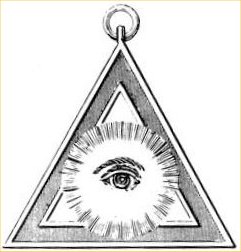 Haggai is the second principal appointed to rule in the chapter. He was a prophet, about whom little is known apart from his prophesy that there would be pestilence and drought because of the failure of the people to finish the rebuilding of the Temple.
Haggai is the second principal appointed to rule in the chapter. He was a prophet, about whom little is known apart from his prophesy that there would be pestilence and drought because of the failure of the people to finish the rebuilding of the Temple.
Haggai declared that God was punishing them for decorating their own house before completing the house of the Lord, and urges Zerubbabel, governor of Judah, and Joshua, the high priest, to rally the people to their primary task.
The name, meaning ‘festive’, refers to one of the books of the Bible and represents that of a prophet. That is why the second principals sceptre carries an ‘All seeing eye’ that symbolically represents the omnipresence of the Almighty.
His role after the return of the Jews from exile in Babylon was that of scribe and he acted in that capacity in the first Sanhedrim that was set up after they settled again in Jerusalem.
The Sanhedrim was the council set up to govern the people of Israel and was composed of six persons from each of the 12 tribes. One of those representatives was the prince that presided over the Sanhedrim and another was the scribe who recorded their decisions. If a deciding vote had to be given the High Priest was brought in to do so. Thus, all those present as our principal’s were needed to conclude essential business.
Haggai is remembered mostly for his four prophecies delivered over three months to urge the people to rebuild the Temple. It has been said that these prophecies should be written down and published in some sort of religious book. Because of the prophecies he is known as the Prophet Haggai.
Third Principal
 Joshua is the third principal who assists in ruling the chapter.
Joshua is the third principal who assists in ruling the chapter.
Joshua was actually Jeshua. People kept confusing him with Joshua of Moses’ time. Jeshua (Joshua) was head of the ninth priestly order and a Levite; as such he did not take up arms. The Levites were the religious men charged with doing the Lords work and were really the 13th tribe of the Israelites. He assisted in the reformation of Jerusalem under the leadership of Nehemiah.
The name means ‘the God who saves’ and the role is not only that of a priest but of a High Priest. It is Joshua, and not his father Josedech, who has that honour. That is why the third principals sceptre has a ‘mitre’ at its head. (This is often misunderstood as the words in our ritual say “Joshua, son of Josedech, the High Priest”)
Joshua was the High Priest during the rebuilding of the Temple. He was the grandson of Seraiah who was the High Priest when the Temple was destroyed by the forces of the Babylonish General. He reinstituted the correct Temple rituals, without which the older beliefs and practices of Judaism might have been lost forever.
In earlier days, and still in a few English chapters, the principal in the 3rd chair wore a breastplate that had 12 jewels representing the 12 tribes of Israel, the same as those represented on the ensigns on the floor. The three principal’s used to wear as headgear the items now represented on their sceptres. In a very few chapters, headress generally in the form of crowns, is still worn.
The mitre and breastplate of the first principal represent the omniscience of the Almighty (or in modern English a complete knowledge and awareness of the Almighty) who has entrusted to his people, and to us the priests in particular, the sacred knowledge of the Scriptures, prayers and ceremonies that God revealed to Israel. That is why it is usually the first principal’s responsibility to pray and read passages from the Volume of the Sacred Law at our convocations.
It is no coincidence that the name that this principal bears is the same in Hebrew as that which we know as Jesus. For in the earlier days of this Order its Christian significance was paramount and there was much in the ritual about Jesus as the High Priest entering the Holy of Holies to make atonement for the sins of the people. You will recall that in the exaltation ceremony the principal sojourner refers to that priestly practice.
Judah
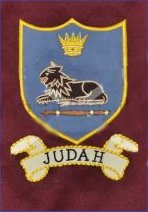 The banner of Judah was of crimson or scarlet and designated by a Lion together with a sceptre, probably suggested by Genesis 49, verse 10, “The sceptre shall not depart from Judah” all subsequent history emphasises the kingly power of the tribe.
The banner of Judah was of crimson or scarlet and designated by a Lion together with a sceptre, probably suggested by Genesis 49, verse 10, “The sceptre shall not depart from Judah” all subsequent history emphasises the kingly power of the tribe.
Judah means ‘praise’ in Hebrew. The Latin motto beneath the shield reads ‘Vivat leo de Tribu Juda’, meaning ‘Long live the lion of the Tribe of Judah’. Sometimes there is the additional Latin motto ‘Accubuit ut leo’, meaning ‘He lay down like a lion’. The Talmud says that Jacob’s body had a golden sceptre and crown laid upon it as it was carried to the grave.
To this tribe belong many of the most noted prophets, which have exerted its influence in moulding the life of the nation.
The kingly power of the tribe was not effaced until after the destruction of the city and the Temple by the Romans, under Titus, in the year 70 of the present era.
To the Tribe of Judah was assigned the most honourable station in the camp, in the east, before the entrance to the tabernacle.
Jacob called his sons together to prophesy about each of them. He said: “Judah, your brothers shall praise you; your hand shall be upon the neck of your enemies; your father’s sons shall bow down before you.” (Genesis: 9)
The position of the Tribe of Judah as the leader of the 12 tribes is confirmed in Jacob’s next reference: “Judah, you are a lion’s cub; from the prey, my son, you return, and like a lion you crouch and lie down, like a lioness whom one fears to rouse. The sceptre shall not depart from Judah, nor the ruler’s staff from between his feet until he comes to whom it belongs”. These words explain the emblem of a lion with a sceptre beneath its feet and sometimes a crown above it. King David and his successors, including King Solomon, were of the Tribe of Judah.
Napthali
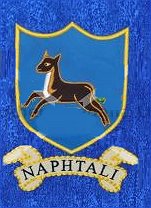 Their banner of was blue, designated by the Hind. “Naphtali is a hind let loose; he giveth goodly words”. This prophecy denotes that the posterity of Naphtali should be spirited and free people, and the tribe should be fruitful and multiply. Thus from four sons which Naphtali brought with him into Egypt proceeded upwards of 50,000 descendants when they were emancipated from their captivity.
Their banner of was blue, designated by the Hind. “Naphtali is a hind let loose; he giveth goodly words”. This prophecy denotes that the posterity of Naphtali should be spirited and free people, and the tribe should be fruitful and multiply. Thus from four sons which Naphtali brought with him into Egypt proceeded upwards of 50,000 descendants when they were emancipated from their captivity.
Their portion of the Holy Land was in Upper Galilee, a country always noted for the productiveness of its soil.
It means ‘to wrestle’ or ‘to struggle’ in Hebrew. This fits with Jacob’s words: “Naphtali is a doe that after struggle is set free and bears beautiful fawns”, which explains why the emblem on this standard is a lively doe or hind.
The fertility of the land that was occupied by this tribe is again emphasised by the words of Moses: “Naphtali is abounding with the favour of the Lord, is full of blessing and will inherit the territory south of the lake.”
The Latin motto ‘Cerva emissa’ means ‘A hind let loose’ or ‘Behold, a hind that gives birth’.
The tribe’s jewel was an emerald
Asher
 This banner was of purple and bore a flourishing tree or a cup. Prince Pagliel unfurled the banner of Asher. Asher’s tribe is promised a tract of the Holy Land which should be fruitful, and accordingly it produced the necessaries of life in abundance. Mount Carmel abounded in the choicest fruits. It means ‘happy’ in Hebrew. From the words of Moses: “Most blessed of sons is Asher who is favoured by his brothers and is able to bathe his feet in soothing oil.” (Deuteronomy: 33).
This banner was of purple and bore a flourishing tree or a cup. Prince Pagliel unfurled the banner of Asher. Asher’s tribe is promised a tract of the Holy Land which should be fruitful, and accordingly it produced the necessaries of life in abundance. Mount Carmel abounded in the choicest fruits. It means ‘happy’ in Hebrew. From the words of Moses: “Most blessed of sons is Asher who is favoured by his brothers and is able to bathe his feet in soothing oil.” (Deuteronomy: 33).
The tribe’s happiness could also be attributed to the fertility of the territory it occupied, which produced abundant crops, including the best fruit. Jacob says: “Asher’s food will be rich: he will provide delicacies fit for a King”. (Genesis: 49). The emblem on the ensign is thus, either a flourishing tree or a golden goblet or urn.
The tree is probably meant to be an olive that gives the oil mentioned earlier, while the golden vessels are those used for storing olive oil, which has always been a symbol of fruitfulness and plenty. The Latin motto is: ‘Prebebit delicias regibus’, meaning ‘He will provide delicacies for kings’.
The tribe’s jewel is an agate.
Dan
 Dan was the next largest to Judah and it was for this reason that it was placed in the rear.
Dan was the next largest to Judah and it was for this reason that it was placed in the rear.
It means ‘judge’ in Hebrew. This fits with what Jacob says” “Dan will provide justice for his people as one of the tribes of Israel”. (Genesis: 49).
The emblem on the ensign is derived from Genesis: “Dan will be a serpent by the roadside and a viper along the path that bites the horse’s heels so that its rider tumbles backwards”. (Genesis: 49). Some ensigns depict the snake biting the horse’s heel, some just the snake.
The Midrash says the emblem of Dan is a lion cub, from Moses’ words: “Dan is a lion’s cub springing out of Bashan”. Yet another variation is an eagle with a snake in its claws, but this may be due to connections made between the 12 tribes and the signs of the zodiac; in this case Capricorn, represented by a flying eagle with a snake in its talons.
Their banner was of bright green colour. The name of Dan signifies judging, and, therefore, Jacob said: “Dan shall judge the people” meaning, that tribe was to be the head of one of the great divisions in the wilderness. He said further: “Dan shall be a serpent by the way”. The Tribe of Dan was remarkable for defeating their enemies by policy rather than by force, in support of which there are many instances in the Bible.
The tribe of Dan, was, however, ringleader of idolatry and was the first apostatise from God.
Benjamin
 Benjamin had a green banner, emblazoned with a wolf, because it was over a warlike and cruel tribe.
Benjamin had a green banner, emblazoned with a wolf, because it was over a warlike and cruel tribe.
It means ‘son at the right hand’ in Hebrew.
This reflects Benjamin’s status as his grandfather Jacob’s favourite after the long absence of his father Joseph. It is also linked to the words of Moses: “Let the beloved of the Lord always rest secure in Him, for He shields him all the day long and the one whom the Lord loves rests upon his breast”. (Deuteronomy: 33). Jacob’s words: “He is as a ravenous wolf that in the morning devours its prey, and in the evening divides the plunder”, Genesis:49 refers to the warlike nature of this tribe and is why the ensign usually depicts a wolf.
The Latin motto is based on Jacob’s words: “Manus comedit praedam et vesperi dividet spolia’, meaning ‘In the morning he eats the prey and, in the evening, he divides the spoils”.
Benjamin’s jewel was a jasper.
It was predicted “Benjamin shall raven as a wolf; in the morning he shall devour his prey and at night he shall divide the spoil”. Though Benjamin was a great favourite with Jacob, being the youngest son, yet he conferred no peculiar blessing upon him. He is described as the father of a fierce and warlike people. This is evident proof that Jacob acted upon the influence of divine inspiration. The tribe accordingly had a character as predicted and made war single handed against all other tribes and overcame them in battle.
Saul, who sprang from this Tribe, also possessed great military talents. His whole life was spent in war, and at length, he, as well as his sons, was slain in battle. It was one of the smallest tribes.
Manasseh
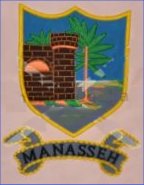 This tribe had a flesh-coloured banner with a device of vine, planted by the side of a wall. It was predicted that the tribe Joseph should be a fruitful vine growing by a well-watered soil and shooting forth two luxurious branches, the Tribes of Ephraim and Manasseh.
This tribe had a flesh-coloured banner with a device of vine, planted by the side of a wall. It was predicted that the tribe Joseph should be a fruitful vine growing by a well-watered soil and shooting forth two luxurious branches, the Tribes of Ephraim and Manasseh.
It means `to cause forgetfulness’ in Hebrew. This was a reference either to Jacob apparently forgetting that Manasseh was the elder son of Joseph, or to Manasseh’s need to forget that his younger brother had been the first to receive Jacob’s blessing.
This confusion is confirmed in the Midrash, which states that the Manasseh’s emblem is a wild ox or a unicorn, though the ox had already been taken by the Tribe of Ephraim.
The emblem used in the Royal Arch is derived from Jacob’s words: “Manasseh is a fruitful vine, near a spring, whose branches climb over a wall”. (Genesis: 39). Sometimes the emblem is a palm tree, in reference to other words of Moses: “May the land of Manasseh be blessed with unripened fruit, rich with the best fruits of each season”.
The Latin motto on this ensign is ‘Ramus fecundus juxta fontem’, meaning ‘A fruitful bough close to a spring’. Manasseh’s jewel was an onyx.
The prediction was fulfilled in the pre-eminence of Joseph. It was said: “The archers sorely grieved him and shot at him and hated him”, referring to the persecution of his brethren who sold him into Egypt at the false accusation due to which he was thrown into prison. Nevertheless, his bow abode in strength, and the arms of his hand were made strong by the mighty God of Jacob. As his enemies were termed archers, so he is said to be armed with a bow in his own defence, by which he triumphed over all his enemies, and rose to the highest state of worldly prosperity.
Issachar
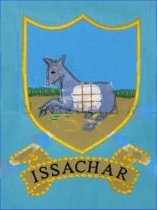 Its colour was sky blue, and had for its device a strong ass beneath its burden. The ass is a patient animal and a proper symbol of labour.
Its colour was sky blue, and had for its device a strong ass beneath its burden. The ass is a patient animal and a proper symbol of labour.
The ass crouching beneath its burden was the opposite symbol of the indolent character of this tribe, who would prefer a submission to every species of tyranny and oppression rather than be at the trouble of asserting their material rights in the field of battle, for an ass, though a strong and hardy animal, would rather sink tamely under a heavy load than shake it off by an exertion of its bodily powers.
Issachar means ‘a man who is a reward’ or ‘a man who is rewarded’ in Hebrew. How does this fit with what Jacob says: “Issachar is a strong ass lying down between two burdens”, (Genesis: 49). which is at least the picture before us and fits one of the usual Latin mottos: ‘Intra onera accumbens’ meaning ‘Lying between burdens’?
This tribe was originally given a fertile area of the Promised Land but lost it through indolence and its preference to pay tribute to a conqueror rather than to fight for it. Though the ass is usually a sign of physical strength, here it is shown giving way, bending its back under the burden placed on it, and working as a meagrely rewarded slave.
Leah, Jacob’s wife, says: “God has given me my reward because I gave my slave to my husband”. Genesis: 30). So, she named the boy Issachar, the man who was, at least in that situation, a reward. The Latin motto that sometimes appears on this ensign is ‘Accubans inter terminos’, meaning ‘Giving way (or Giving up) between limits’. It is one of the tribes that is least referred to in the Bible. On the High Priest’s breastplate, it is represented by an amethyst jewel.
Accordingly, the posterity of Issachar sat down quietly upon the land allotted to them and cultivated it with diligence and assiduity, instead of employing themselves in war or in mercantile pursuits. They were lovers of peace and quietness.
Zebulon
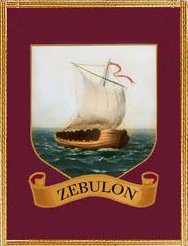 This banner was purple, and bore the device of a ship, symbolic of the prophecy; ‘Zebulun shall dwell at the haven of ships; and his border shall be unto Zidon’.
This banner was purple, and bore the device of a ship, symbolic of the prophecy; ‘Zebulun shall dwell at the haven of ships; and his border shall be unto Zidon’.
The ensign means ‘a place where one dwells’ in Hebrew, a reference to Jacob’s words: “Zebulon shall dwell by the shore of the sea and he shall be a haven for ships; and his border shall extend as far as Sidon”. (Genesis: 49).
This explains very satisfactorily why ships are displayed on this ensign. The Latin mottos add naturally to this message: ‘In litore maris habitabit’ meaning ‘He shall dwell on the shore of the sea’ or ‘Tam ipse naves portu in portum’, meaning ‘As a safe haven for ships he is himself such a harbour’. Both refer to the tribe’s coastal territory, where ships could find a safe haven that was easy to enter and leave. Moses later said of this tribe: “They will feast on the abundance of the sea and the treasures hidden in the sand”.
An alternative name for this tribe was Zabulon, which was once associated with our Royal Arch as it signified the place where God came to dwell on the Ark of the Covenant. It was later changed to ‘Jabulon’ which led to confusion.
Reuben
 This banner was red, and had the Device of a man, because Reuben was the firstborn of his father, who predicted that he would be as unstable as water.
This banner was red, and had the Device of a man, because Reuben was the firstborn of his father, who predicted that he would be as unstable as water.
Reuben, means ‘Behold, a son’ in Hebrew. Jacob says: “Reuben, thou art my first-born, my might and the beginning of my strength, excelling in honour and excelling in power”. (Genesis: 49).
However, later Reuben displeased his father by laying with his father’s concubine in his father’s bed, prompting Jacob to say: “Turbulent as the waters, you will not excel; because you went up onto your father’s bed, onto my couch, and defiled it”. This explains the waves depicted on the ensign and the Latin motto ‘Aquarum instar ruens’, meaning ‘Rushing like waters’.
Reuben’s conduct was unpredictable. His instability was like the overflowing waters that can break all restraints. An alternative motto is ‘Primogenitus meus’, meaning ‘My firstborn’.
His father said: “Thou shalt not excel”, and gave as his reason that, as water by a natural propensity, inherent in its substance, flows from its source in an elevated position to a lower place so should Reuben fall from his birthright and subside into an inferior situation amongst the tribes.
And the prophecy was remarkably verified, for nothing great or praiseworthy has been recorded respecting the posterity of Reuben; they were inferior in number to the other tribes; and the prominence was given to Judah.
Simeon & Levi
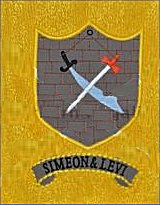 This banner was yellow, and emblazoned with a sword and dagger.
This banner was yellow, and emblazoned with a sword and dagger.
It means ‘hearing’ in Hebrew. Simeon is usually linked with his brother Levi as the words of Jacob make clear: “Simeon and Levi are brothers – their swords are weapons of violence. Let me not enter their council nor join their assembly, for they killed men in their anger and at their pleasure they have hamstrung oxen”. Here Jacob is referring to the massacre of the Shechemites by the Tribes of Simeon and Levi in revenge for an attack on them.
Jacob says: “Their anger for it was fierce and their wrath which was so cruel”. It is therefore not surprising that this ensign depicts a sword or scimitar crossed with a dagger or a knife. The Jewish Midrash states that Simeon’s device was a city, meaning Shechem, and some old Royal Arch chapters still have this displayed on their ensign. The usual Latin motto is ‘Vasa iniquitatis bellantia’, meaning ‘Implements for fighting injustice’, however some ensigns have the alternative ‘Dividam et dispergam’ meaning ‘I will divide and scatter’. (Genesis: 49).
The tribe’s jewel was a topaz.
Simeon and Levi were represented by instruments of war, the former by a sword and the latter by a dagger, Alluding to the abhorrence testified by the dying patriarch to the cruelty of his two sons in the barbarous murder of the Shechemites under the assurance of kindness and good faith, their father said: “Cursed be their anger, for it was cruel; I will divide them in Jacob and scatter them in Israel”.
These sons being associated in wickedness, it was ordained by a superintending providence that their posterity should be disunited; that they should not be furnished with an opportunity of working evil upon their brethren. Hence the Tribe of Simeon and Levi had little or no possessions in the Promised Land, but dwelt in the midst of Judah; some of them wandered in search of a dwelling-place as far as Mount Seir and the deserts of Gideon. As for the Tribe of Levi, it was entirely dispersed amongst the other tribes and devoted exclusively to the service of the altar.
Gad
 banner of white, emblazoned with a troop of horsemen. It means ‘a troop’ or ‘a marauding band’ in Hebrew.
banner of white, emblazoned with a troop of horsemen. It means ‘a troop’ or ‘a marauding band’ in Hebrew.
This fits with the words of Jacob: “A gang of raiders shall attack him, but he will pursue them at their heels”, which agrees the Jewish tradition that the Gadites succeeded in expelling the Ammonites, the Moabites and the Ephraimites who constantly raided their borders. Jephthah, who is mentioned in the second degree ceremony, belonged to this tribe, famed for its courage and success in war.
It is appropriate that the emblem representing it is a troop of horses with riders, whose pennants sometimes display a lion, for Moses said of Gad: “He lives like a lion, tearing at arm and leg”.
The Midrash describes Gad’s emblem as a camp or tent, and that emblem is uses on some chapter’s ensigns. The Latin motto ‘Ipse tandem devincit’ means ‘He at last will subdue’ though occasionally you may see ‘Cohors delebitur sed non eo’, meaning ‘The band will be destroyed, but not him’.
The jewel of this tribe is a jacinth.
Jacob foretold the difficulties to the progress of the posterity of Gad due the hostility of their neighbours but though they were doomed to be sometimes defeated, yet in the end, by Divine assistance they would overcome all difficulties and establish themselves firmly and peacefully in the position allotted to them. This prophecy was fulfilled, for the tribe occupying a country beyond Jordan, was necessarily exposed to the incursions of the Ammonites, from whom it suffered severely, but at length, through the military talents of Jophthah, the Ammonites were finally subdued and gave no more trouble.
Ephraim
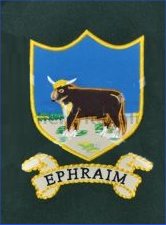 This banner was green, and emblazoned with an ox.
This banner was green, and emblazoned with an ox.
It means ‘doubly fruitful’ in Hebrew. This is appropriate because it fits the division of the inheritance of Joseph between his two sons Ephraim and Manasseh. Reuben’s unruliness had led to Jacob giving Joseph his portion, meaning he had a double portion to pass on to his two sons.
The ox depicted on the ensign refers to the words of Moses: “In majesty he is like a firstborn bull; his horns are the horns of a wild ox, and with them he will gore the nations even unto the ends of the earth”. (Deuteronomy: 33). Another translation reads: ‘His horns are like the horns of unicorns’ and that is why some ensigns display that creature.
The Latin motto ‘Amans triturare’, meaning ‘Fond of threshing’ probably refers to the idea of this tribe trampling like an ox upon the corn and lands of others.
Ephraim stepped into the inheritance of his father Joseph, and his tribe was elevated to a leading position. The ox, was emblematic of patience, industry and strength; thus, Jehovah said “Ephraim is the strength of mine head ”.
The Pedestal
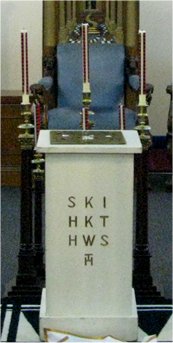 In the centre of the vault the sojourners discovered a pedestal, or block of white marble, in the form of a double cube, representing an Altar of Incense. In Craft Masonry, the smooth ashlar placed at the senior warden’s pedestal represents perfection at the end of a Mason’s journey through this material world. So the pedestal in a RA chapter, being double a perfect ashlar, may be said to represent in its lower portion, perfection in material or earthly matters, and in its upper half, perfection in spiritual matters. It may also be considered to represent earth and heaven. In the lower half our earthly existence, but, in the upper half, our contemplation of our higher or spiritual future.
In the centre of the vault the sojourners discovered a pedestal, or block of white marble, in the form of a double cube, representing an Altar of Incense. In Craft Masonry, the smooth ashlar placed at the senior warden’s pedestal represents perfection at the end of a Mason’s journey through this material world. So the pedestal in a RA chapter, being double a perfect ashlar, may be said to represent in its lower portion, perfection in material or earthly matters, and in its upper half, perfection in spiritual matters. It may also be considered to represent earth and heaven. In the lower half our earthly existence, but, in the upper half, our contemplation of our higher or spiritual future.
On the top of the pedestal was a plate of gold; white being an emblem of innocence and gold of purity. On the front were engraven the initials of the three Grand Masters who presided at the building of the former Temple, namely Solomon King of Israel, Hiram King of Tyre and Hiram Abiff and were meant to perpetuate their names as well as to commemorate the circumstances and proceedings attending the erection of that structure. There was likewise the triple tau, a mark or character affixed to the summonses of Royal Arch Masons.
The tau is that mark or sign spoken of by the Angel whom Ezekiel saw in the spirit, when it was said to the man with the writer’s inkhorn: “Go through the midst of the City, through the midst of Jerusalem, and set a mark on the foreheads of the men that sigh and that cry for all the abominations that be done in the midst thereof.” By which mark they were saved from amongst those who were slain for their idolatry by the wrathful displeasure of the Most High. In ancient times this mark was placed on those who were acquitted by their Judges in proof of their innocence; and military commanders caused it to be placed on the foreheads of those who returned unhurt from the field of battle denoting that they were in perfect life. For these reasons it has ever been considered a mark or sign of life.
The union of the taus alludes to the Grand Triune Deity, by whom the gloomy, horrific, and unshapen chaos was changed into regular form and peaceful existence.
The pedestal is white, representing white marble, a brilliant stone and a symbol of purity and immortality. It echoes the perfect ashlar which a master Mason constantly works on to perfect his Masonic life, now transformed into a fitting monument to the builders and supporting the symbols of eternity. The perfect ashlar is therefore a stepping stone to the Royal Arch, the master Mason stepping away from material matters towards the spiritual.
In the book of Kings we are told that King Solomon built the temple and that the altar, which was where the stone tablets of the Covenant were kept, was brought into the temple in a great ceremony. That temple was destroyed by Nebuchanezzar the Assyrian, and our ceremony takes place after the return of the exiles to Jerusalem.
The altar found by our sojourners in the ceremony is in the same form as the one in Solomon’s day, but of white marble. Symbolically the great difference in the materials used underlines the transition from the hardships of the desert to the opulence of King Solomon’s temple.
The Pedestal is shown in your Grand Chapter certificate in the middle of the squared pavement like the craft floorcloth, but the floorcloth of the chapter is different. It shows the perspective view which would have been seen by the sojourner looking down into the vault.
The pedestal is described as a double cube. The bottom cube represents the rough ashlar of the entered apprentice, symbolic of worldly man, engrossed in material things and expecting material rewards for his labours, and still uncouth in the spiritual ideals of Masonry. The top cube is the perfect ashlar made perfect by obedience to the Will of the Great Architect of the Universe, and it symbolises our awareness of a spiritual life.
White symbolises innocence, and that purity and richness are symbolised by the plate on the Pedestal.
On the top of the Pedestal, in addition to the plate of pure gold is placed a circle and a triangle of the same material. The selection of these mathematical figures has ever had a reference to the deity, or some divine attribute. From the most remote period of antiquity the names of God and the symbols of the deity have been enclosed in triangular figures.
In the days of Pythagoras the triangle was considered to be the most sacred of all emblems, and when any obligation of more than usual importance was about to be administered,’ it was always given on the triangle, and when so taken none were ever known to violate it. The Egyptians called it the sacred number or number of perfection; and so highly was it prized by the ancients, that it became among them an object of divine worship. Under the principles of animated nature they gave it the sacred name of God, affirming that it represented the animal, vegetable, and mineral kingdoms.
The central object visible in the vaulted chamber is the pedestal. It is in the form of a double cube and made to resemble white marble. On the front face are letters and a symbol. The letters are the initials of the three Grand principal’s at the time of the completion of King Solomon’s Temple in Jerusalem. ‘SRI’ stands for ‘Solomon Rex Israelorum’ (‘Solomon, King of Israel’). ‘HRT’ similarly stands for ‘Hiram, King of Tyre’ and ‘HAB’ for ‘Hiram Abiff’.
The symbol is called the triple tau. Some ancient texts suggest that it was originally a ‘T’ over an ‘H’, standing for ‘Templum Hierosylum’ (‘Temple of Jerusalem’) but in Royal Arch Masonry we prefer to interpret it differently. The letter ‘T’ is called ‘tau’ in Hebrew and Greek. It has often been supposed that three taus was the mark placed on the heads of those referred to in Ezekiel 9:4, ‘And the Lord said unto him, go through the midst of the city, through the midst of Jerusalem, and set a mark upon the foreheads of the men that sigh and that cry for all the abominations that be done in the midst thereof’. They were to be protected from the destructive wrath of God, directed towards idolaters. Military commanders at the time also used the mark to indicate soldiers who were unhurt in battle, showing that they were fit and well. For this reason, it has been called the mark of life.
The pedestal is acknowledged as the sacred centre of our chapter rooms as it is the only focus for the reverential or hailing sign. Because of its origins as explained in the Mystical Lecture, the reverential or hailing Sign should never be directed to an individual, but always to the pedestal on which the sacred word was found.
The reverential or hailing sign is only given when opening or closing a chapter, or by companions who arrive after the chapter is opened or leave before the chapter is closed. At other moments during the meeting when a companion feels it appropriate to acknowledge the principal’s (e.g. when rising to speak), a court bow will suffice.
Volume of the Sacred Law
 The Volume of Sacred Law (VSL) is the Masonic term for whatever religious or philosophical texts are displayed during a chapter meeting.
The Volume of Sacred Law (VSL) is the Masonic term for whatever religious or philosophical texts are displayed during a chapter meeting.
A large VSL is placed on the floor cloth between the five regular platonic bodies and the working implements. It should be placed so as to be read from the west. A small VSL should be made available by the kneeling stool in the west and for use in the obligations.
In English-speaking countries, this is most often the King James version of the Bible or another standard translation of the Bible.
If a chapter has non-Christian members, other texts may be used, and in chapters with a membership of mixed religions it is common to find more than one sacred text displayed. Every candidate is given his choice of religious text for his obligation according to his beliefs.
Border and Colours Used in Royal Arch
 The Lord gave Moses instruction in the colours to be used in the fabric of the tabernacle. These colours were red, purple and blue, or blue, purple and scarlet depending on which version of the Bible you read.
The Lord gave Moses instruction in the colours to be used in the fabric of the tabernacle. These colours were red, purple and blue, or blue, purple and scarlet depending on which version of the Bible you read.
These colours were said to represent the elements. Red for fire, purple for the sea as the blood of shellfish dyes it and blue for the sky. The Lord chose Bezaliel and Aholiab, other names in our ritual, to prepare and sew the cloth for the tabernacle.
Blue: Is the symbol of universal friendship and benevolence. It is the appropriate colour of the symbolic
degrees, the possession of which is the first-step in the progress for the search for truth to the now
initiated.
Purple: Is a symbol of union, and refers to the intimate connection of ancient Craft and Royal Arch
Masonry, hence it is the appropriate colour of the degrees, which must be passed through
in the prosecution of the search. The mosaic sign refers to the restoration of the leprous hand back
to health.
Scarlet: Is a symbol of fervency and zeal, and was appropriated by the Royal Arch because it is by these
qualities that the beginner must expect to be successful in his search.
White: Is the symbol of purity and peculiarly appropriate to remind that it is only by purity of his life that he can expect to be found worthy of the reception of truth.
The Square
The square confirming the indissoluble link between Craft and Royal Arch is actually a builder’s square, two equal flat-edged metal or wooden arms joined at a perfect ‘right angle’ – defined in geometry as 90 degrees. It enables the stonemason, bricklayer, architect, or other builder to draw or prove perfect square corners in plans, carved stones and corners.
The right angle is important in buildings, to make sure that stones and bricks are square, meeting and joining at the correct angle, so they don’t crowd each other or lean improperly. Buildings will be stronger and reliable when angles are properly squared.
In Craft and Royal Arch Masonry, this is a symbol of our ability to use the teachings of conscience and morality to test or try the rightness of our actions. It is a symbol of the ‘Golden Rule’. After all, to deal ‘squarely’ with someone is to treat them fairly and honestly, as we ourselves would want to be treated.
It also symbolises the authority of the master of the workmen, whose perfect square was the standard against which all the other measuring squares on the building site were checked for accuracy. In early days, the simple geometric techniques for the construction of a perfect square was a secret kept and preserved by master builders, so the master (presiding officer) of a Mason’s lodge still wears a square as his emblem.
The Scroll
 “We congratulate you on being admitted to the light of our Order and it is with satisfaction we express our confidence that your future conduct will fully justify our partiality in having exalted you into this supreme degree so truly denominated the essence of Freemasonry. You will now read the scroll you brought with you out of the vault.”
“We congratulate you on being admitted to the light of our Order and it is with satisfaction we express our confidence that your future conduct will fully justify our partiality in having exalted you into this supreme degree so truly denominated the essence of Freemasonry. You will now read the scroll you brought with you out of the vault.”
“In the beginning God created the heaven and the earth. And the earth was without form and void; and darkness was upon the face of the deep. And the spirit of God moved on the face of the waters.”
And God said: “Let there be light and there was light.”
Such, my newly exalted companion are the first words of that Sacred Volume, which contains the record of God’s revealed Will. Let us therefore, bless, praise and magnify His Holy Name for the knowledge vouchsafed us, and walk worthily in the light which shines around.
The scroll is of ‘vellum or parchment’, meaning a writing surface made from the skin of a goat, sheep or lamb. It is a ‘scroll of vellum or parchment’ and not a book that is found because we are trying to tell a tale from Old Testament times when documents were in such a form. The Jewish scriptures are kept as parchment scrolls in a locked cabinet called a tabernacle.
On it is written the opening words of the Book of Genesis: ‘In the beginning God created the heavens and the earth. Now the earth was formless and empty, darkness was over the surface of the deep, and the Spirit of God was hovering over the waters. And God said, let there be light, and there was light.’ (Genesis 1:1-3).
This is a reminder of the requirement that Freemasons believe in a supreme being. There is no prescription of how that belief is expressed. Freemasonry is not a religion, and accepts into membership anyone who states a belief in a supreme being, providing all other requirements are met.
From God’s existence sprang all the fruits of creation, including man. It is the relationship between man and God that is studied in the Royal Arch, as compared to the relationship between man and man studied in the three Craft degrees.
The Shovel
 The pick, crow and shovel were the implements made use of by the sojourners who were sent to prepare the ground for the foundation of the second temple, the pick to loosen the ground, the crow to take purchases and the shovel to clear away the rubbish and loose earth. These we symbolise.
The pick, crow and shovel were the implements made use of by the sojourners who were sent to prepare the ground for the foundation of the second temple, the pick to loosen the ground, the crow to take purchases and the shovel to clear away the rubbish and loose earth. These we symbolise.
The shovel is used by the candidate, acting as an assistant sojourner, to clear away the rubbish resulting from the work of his two colleagues. It reminds us again of the transient nature of this life on earth. The value we place on the companionship of our fellows does not decay as time progresses because what we value is their nature and their strength of character. All of our days are numbered and the mortal body will fade away in the grave. When the rubbish of the body is disposed of, we hope that the spirit will rise into immortal and eternal life.
The manner in which the body is laid in the grave is fully depicted by the work of the shovel and we, with humble but holy confidence, hope that when these earthly remains have been properly disposed of, the spirit will arise to immortal life and everlasting bliss.
The Pick
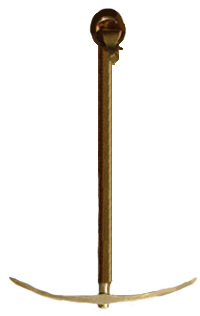 The Pick, Crowbar and Shovel were the implements made use of by the Sojourners who were sent to prepare the ground for the foundation of the Second Temple, the Pick to loosen the ground, the Crowbar to take purchases and the Shovel to clear away the rubbish and loose earth. These we symbolise.
The Pick, Crowbar and Shovel were the implements made use of by the Sojourners who were sent to prepare the ground for the foundation of the Second Temple, the Pick to loosen the ground, the Crowbar to take purchases and the Shovel to clear away the rubbish and loose earth. These we symbolise.
The shovel is used by the candidate, acting as an assistant sojourner, to clear away the rubbish resulting from the work of his two colleagues. It reminds us again of the transient nature of this life on Earth. The value we place on the companionship of our fellows does not decay as time progresses because what we value is their nature and their strength of character. All of our days are numbered and the mortal body will fade away in the grave. When the rubbish of the body is disposed of, we hope that the spirit will rise into immortal and eternal life.
The manner in which the body is laid in the grave is fully depicted by the work of the Shovel and we, with humble but holy confidence, hope that when these earthly remains have been properly disposed of, the spirit will arise to immortal life and everlasting bliss.
The Crow
 The Pick, Crowbar and Shovel were the implements made use of by the Sojourners who were sent to prepare the ground for the foundation of the Second Temple, the Pick to loosen the ground, the Crowbar to take purchases and the Shovel to clear away the rubbish and loose earth. These we symbolise. The pickaxe is used by the first assistant sojourner to loosen the ground during the exaltation ceremony.
The Pick, Crowbar and Shovel were the implements made use of by the Sojourners who were sent to prepare the ground for the foundation of the Second Temple, the Pick to loosen the ground, the Crowbar to take purchases and the Shovel to clear away the rubbish and loose earth. These we symbolise. The pickaxe is used by the first assistant sojourner to loosen the ground during the exaltation ceremony.
The stroke of the Pick reminds us of the sound of the last trumpet, when the ground shall be shaken, loosened, and the graves deliver and give up their dead. This is referred to in the First Letter of St Paul to the Corinthians 15:51-53, ‘Behold, I shew you a mystery; We shall not all sleep, but we shall all be changed, In a moment, in the twinkling of an eye, at the last trump: for the trumpet shall sound, and the dead shall be raised incorruptible, and we shall be changed. For this corruptible must put on in corruption, and this mortal must put on immortality’.
It is a reminder that our days on Earth are numbered, that eventually we will be summoned to the Grand Lodge above, and that we should therefore always conduct ourselves in such a manner that we will never be ashamed of the reputation we leave behind us.
The Trowel
The trowel being used to spread the cement which binds all the parts of the building into a common mass, and we are taught to unite all the members of the Masonic family,wheresoever dispersed over the globe, into one companionship of brotherly love.
The Sword
 The sword and trowel were adopted by Royal Arch Masons to commemorate the valour of those worthy men who assisted at the building of the second temple, who, with trowel in hand and sword by their side were ever ready to defend the city and Holy Sanctuary against the unprovoked attacks of their enemies, thereby leaving an impressive lesson to future ages; that, next to implicit obedience to all lawfully constituted authority, a manly and determined resistance to lawless violence is the first of social duties.
The sword and trowel were adopted by Royal Arch Masons to commemorate the valour of those worthy men who assisted at the building of the second temple, who, with trowel in hand and sword by their side were ever ready to defend the city and Holy Sanctuary against the unprovoked attacks of their enemies, thereby leaving an impressive lesson to future ages; that, next to implicit obedience to all lawfully constituted authority, a manly and determined resistance to lawless violence is the first of social duties.
The sword needed to be ever ready to defend the City at the rebuilding of the temple and walls of Jerusalem and its introduction into our Order was part of enacting that scriptural situation. The fact that one is made a Prince and ruler when invested in the Royal Arch meant that in the 18th century such an implement would also fit the rank of such a person. The sword even began to replace the trowel in the Craft.
The fact that the sword was presumed to be held in the left hand, as the trowel was in the right, helps to explain why the sash that may once have held a sword is on the right; why the penalty in this Order is given with the left hand, as if holding a sword; and why the toast to our grand originals should be given with the left hand.
The presence of a sword, as that wielded by a worthy defender of the holy places, also explains how easy it was to link the Royal Arch with what was once its immediate partner, the Knight Templar degree. Since all Knights Templar had, in the medieval Order, to be of noble blood the idea of Princes and rulers in this Order made their holders very natural candidates.
The presence of a sword in the chapter room is a constant reminder of the difficulties faced by the rebuilders of the temple in Jerusalem. With broken city walls and surrounded by enemies, the rebuilding of the Temple was carried out in constant danger. The builders and supervisors had to be ready at all times to defend themselves as well as protecting the work already completed.
Kneeling Stool
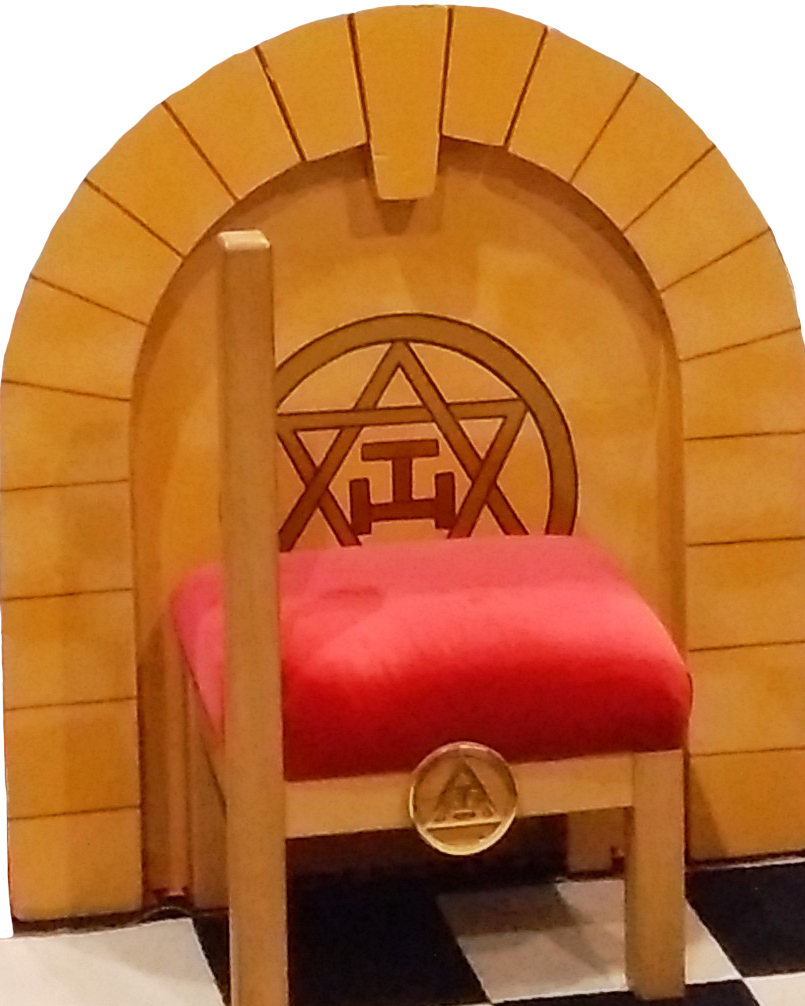 In medieval operative Masons’ lodges, candidates for initiation into the Masons’ Guild were required to kneel with both knees bared on the rough ashlar, so that nothing came between their bodies and the stone. This perpetuated the ancient beliefs that the strength and stability of the stone would thereby be communicated to the candidates, and that their oaths taken on the stone would be inviolable.
In medieval operative Masons’ lodges, candidates for initiation into the Masons’ Guild were required to kneel with both knees bared on the rough ashlar, so that nothing came between their bodies and the stone. This perpetuated the ancient beliefs that the strength and stability of the stone would thereby be communicated to the candidates, and that their oaths taken on the stone would be inviolable.
Research of early speculative Lodges confirm that candidates knelt on a chair or kneeling- stool like the ones we use today. An exposure of the initiation ceremony published in 1765 states that the left knee, on which the Candidate knelt, was the weakest part of the body, symbolising that he was, at that time, the weakest part of the lodge. This implied that he would grow stronger as he advanced, and those of you who have advanced beyond the first degree will recall that this is true.
When we kneel to take our obligations, our hands lie on the Volume of the Sacred Law, reminding us that Freemasonry is not just about moral behaviour, but looks beyond our duties to our fellow man to our duty to God.
The posture taken when praying differs from kneeling in some cultures. In the Masonic ritual, you may come across the instruction: ‘Brethren, turn to the east’.
Candles
The candles should be lit before the opening of the chapter and extinguished after the closing ceremony. The janitor or director of ceremonies would usually attend to this. In some chapters they are extinguished during the ceremony.
We are told in the symbolical lecture that we acknowledge six lights: namely, three lesser, and three greater. These lights are the candles placed in the form of an equilateral triangle; each of the lesser bisects a line drawn between two of the greater, thus subdividing the large triangle into three lesser ones at its extremities, and of themselves forming a fourth in the centre, all of them equal and equilateral. The three greater are usually placed with `their apex to the east with each of the smaller candles bisecting them, thus making an apex to the west
The three greater are usually placed with their apex to the east with each of the smaller candles bisecting them, thus making an apex to the west.
The three greater lights represent the Sacred Word itself, and by their number allude to the creating, sustaining and destroying power of the Almighty. The three lesser lights represent the law, and the prophets; and by their number refer us to the patriarchal, the prophetical or judicial, and the monarchical dispensations, through which the Hebrew nation successively passed.
This arrangement has a geometrical correspondence with the mysterious triple tau, which forms two right angles on each of its exterior lines, and two others by the union of some academics claim that these are emblematical of a fourth step or the essential four stage process for all Freemasons – initiation, passing, raising and exaltation




